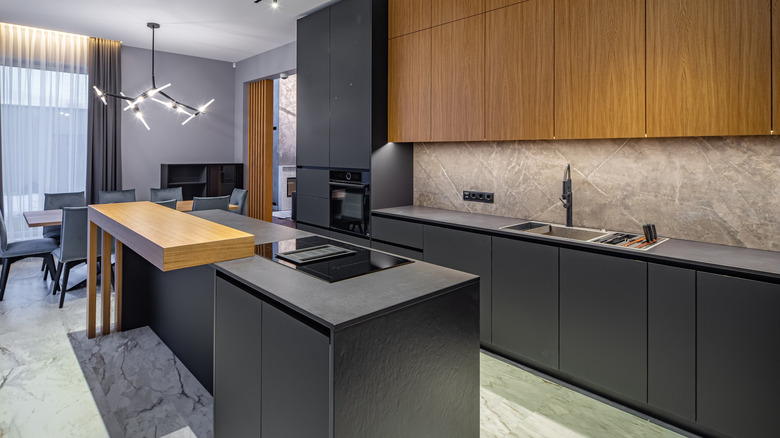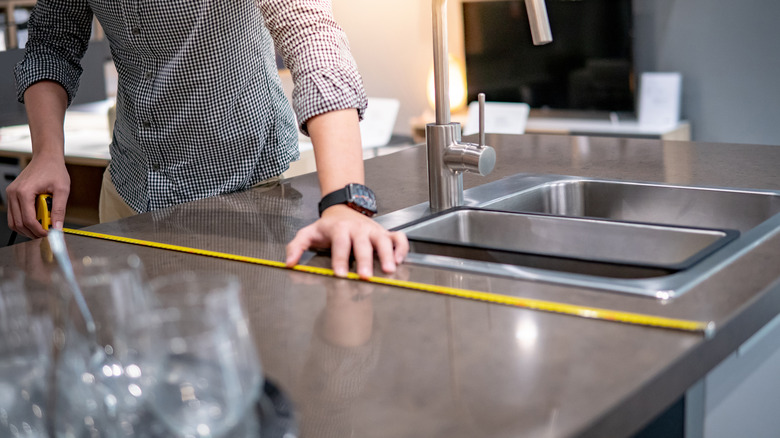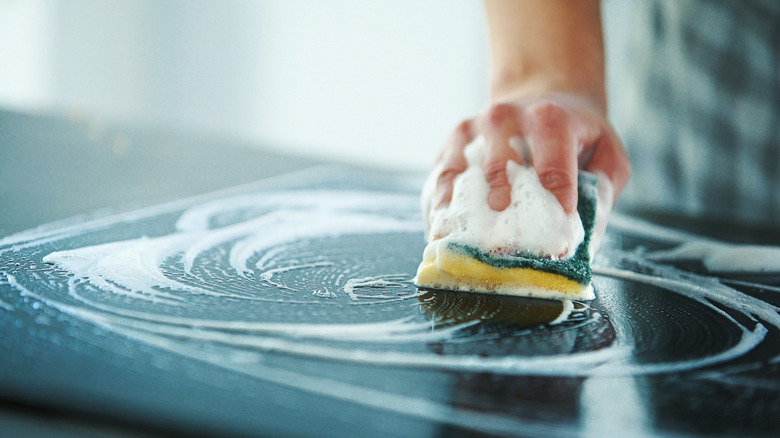Are Slate Countertops Affordable And Practical? What We Know
If you've decided to update your kitchen or bathroom, you'll need to pick your new countertop material. Perhaps you're looking for a modern alternative to granite, or maybe you just want to shake things up a bit. An attractive, low-maintenance option worth considering is slate, a material that's made up of layers of stone. Slate is versatile and durable, and although it's not as cheap as, say, laminate, it can sometimes be more affordable than granite, marble, and quartz. Since it's non-porous, it's almost completely waterproof and generally easy to clean while also having antibacterial properties, making it quite practical for the average homeowner.
One factor to consider when choosing a countertop is whether to go light or dark. You may think that choosing slate will limit you to darker options, but that's not necessarily the case. Depending on where it originates, slate can come in shades of gray and white as well as green, blue, red, and purple. In the U.S., Vermont slate is known for its colorful varieties. These variations ensure that no two slate countertops are exactly the same. Since slate is less busy than granite, any color changes within a slab will be subtle, making it easy to achieve a uniform look across your kitchen or bathroom.
How affordable are slate countertops?
How much do slate countertops cost? Depending on the type of slate, expect to pay about $50 to $100 per square foot. That's compared to $80 to $150 for granite and $50 to $200 for quartz. While not as cheap as standard laminate, which typically costs just $10 to $18 per square foot, investing in slate countertops may be a good option, as they will likely last much longer. Further, slate tiles cost an average of $45 to $75 per square foot, making them slightly more affordable than slabs. But tile countertops may not be everyone's aesthetic cup of tea, and the seams can make them hard to clean, so you may want to stick with solid granite.
While you might be tempted to buy lower-grade slate to save money, that may end up costing you more in the long run. The cheapest and lowest grade slate will be more porous and easier to crack and chip. It's also more prone to staining and reactive to acids. You could (and most likely should) apply a sealer, but even so, getting the highest-quality slate you can afford will keep your countertops looking great for longer. So, while slate countertops can be more affordable than some options, the price you'll pay really depends on the quality you choose.
Slate countertops can be super practical
Good-quality slate is generally waterproof, durable, and can handle almost anything you throw at it, from hot pans to orange juice spills. Its low porosity prevents liquids from soaking in, making it easy to wipe up spills. This also reduces the threat of stains and harbored bacteria. However, keep in mind that slate is prone to scratching and chipping.
The type of slate countertop you choose will determine how practical and easy to clean it really is. For instance, a natural cleft finish is great for a rustic look, and its slightly rough surface will hide any imperfections. However, it can be difficult to maintain, as grime can be hard to remove from the grooves and it can chip easily. A cascade finish is smoother, making it easier to maintain, and it still has a slightly textured effect that hides scratches. A honed finish will be completely flat and smooth, making it extremely easy to clean. However, its smooth surface can also easily show any imperfections and dirt.
While you don't have to worry about keeping your slate countertops polished to a luster like granite, you should regularly clean them, of course. There are some best practices for cleaning slate, but in general, avoid vinegar and ammonia, and if possible, use a cleaner made especially for stone. Also, avoid using dish soap, as it can make it appear cloudy. By following these simple guidelines, your countertops should be fairly easy to maintain, making them quite practical.


